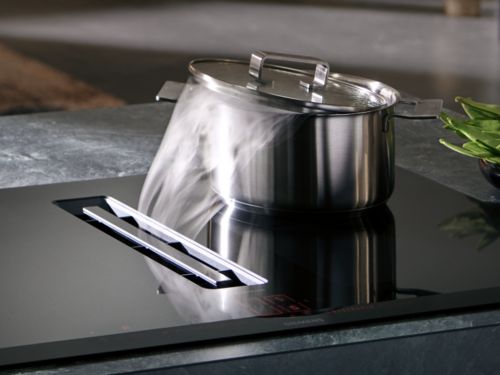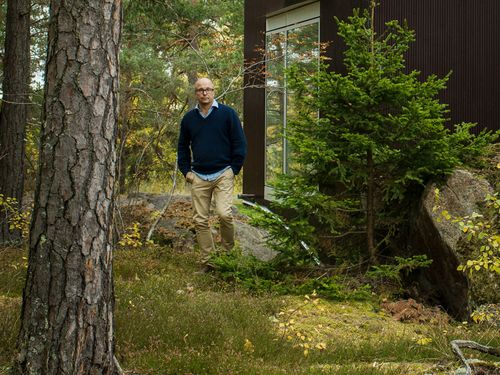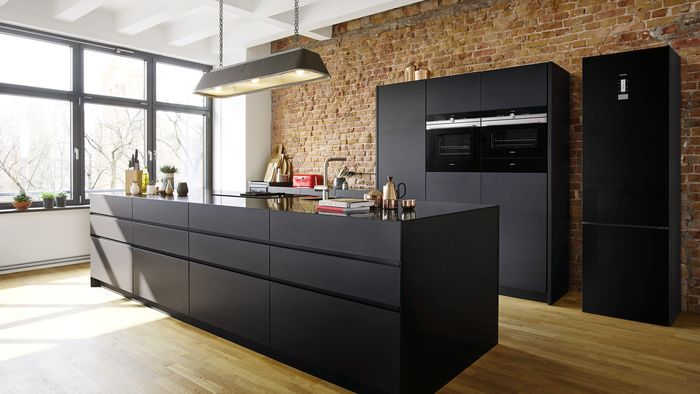Fifteen years ago, Anjo van den Brink volunteered to work as a doorman during Open Monuments Day, all the way at the top of an old grain silo in the corner of the Harbor Quarter in Deventer. Anjo was familiar with the building – the grey giant has defined the city skyline since 1961 – but he had certainly never considered it as a potential future home. But that day, gazing out at the surrounding countryside, Anjo was struck with a thought. How amazing would it be to wake up to this view every morning?
Fast forward fifteen years and we find Anjo’s partner, José van de Griendt, welcoming guests outside at the bottom of the silo. It still looks like an industrial abandoned building from the outside, but on the inside, the silo has been transformed into a spacious, personal and colorful home.
With a clear vision, a truckload of determination and a sizeable weak spot for industrial heritage, Anjo and José managed to convert the old silo into a sustainable living space. And even though the most modern technological solutions allow for comfortable everyday life, the silo’s old character still speaks through the walls.

José, Anjo, not many people would consider buying a giant old grain silo and manage to successfully turn it into a home. But you did. How come?
Anjo: We decided to take on this project because we have a passion for industrial heritage and could really see ourselves living here. Of course, we knew there were going to be challenges that might make things difficult, or even ruin the entire project. But we always had an emergency plan B: we could just place a caravan on the roof and live there!
Why was it important for you to preserve this building?
José: The building is very characteristic, we’re not the only ones who think it’s beautiful. There are many people in Deventer and the surrounding area who love this building.
Anjo: The Grijze Silo defines the look of this city, it holds a prominent position in the skyline. It’s one of the first buildings you see when you drive on the highway west towards Deventer. It’s hard to determine what it means to the city, but it’s also about the value you assign to it yourself. For us, it’s a home, a safe haven.
How long did the entire process take, from that first day on top of the silo to the renovations?
Anjo: It took more than 15 years! There were a lot of people with ideas on how to transform this building, but you’re very limited with what you can actually do with it. The building has a certain structure that makes it hard to break down the walls.
José: Eventually, a single residence seemed like the most feasible plan. And the municipality gave us the chance to realize that.

What were the biggest challenges and milestones during the renovation?
José: The most urgent project was repairing the concrete. When we started the renovation, the building was fenced up, and for good reason: the concrete was literally falling apart.
Anjo: There were also some unexpected ones, like the concrete floor. How can you pump concrete up this high? And how can you lift or carry large and heavy objects all the way up to this floor? That actually had a big influence on what made it into the interior: the size of the elevator and the stairwell.
You chose to work together with I’M Architects for the renovation. Why them?
José: I’M Architects had been involved with the Grijze Silo for a while, they conducted several feasibility studies for the municipality, so they knew the building well. Our vision for the transformation, how we wanted to preserve the building’s character as much as possible, fit perfectly with the designs they created.
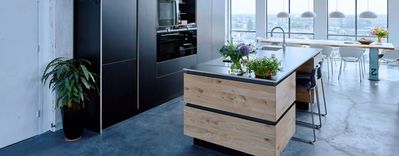
How would you describe the silo’s character post-renovation?
Anjo: I would describe the silo’s character as industrial, more than anything. And besides that, we made sure the design accommodated all of our wishes and preferences. Every need we could think of, we tried to incorporate into this space so it would become a relaxing, energy efficient and functional home. And I think we were pretty successful in doing so.
How did you turn such a raw, industrial building into a cozy home?
Anjo: We managed to make it feel like a real home by creating different, smaller corners in an open space, cozy spots where you can sit and relax.
José: The space really started to feel like a home when the kitchens were installed. All of a sudden, there’s access to a good cup of coffee, and you notice visitors lingering, so getting renovation work done becomes a little more tricky. But a kitchen really makes a space liveable.
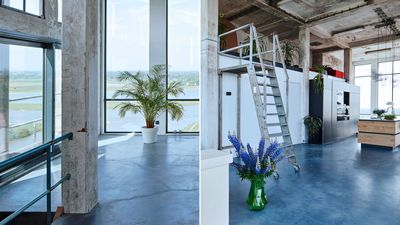
The kitchen is placed in the center of your living space. What was the idea behind this design?
Anjo: Keuken Atelier designed the kitchen, together with Siemens, with the idea to make it a functional statement piece in the space, one that met all of our needs. For example, we have two dishwashers. We don’t have that many dishes, but in our previous home we noticed that more often than not, we hadn’t cleared out the clean dishes by the time we had new, dirty dishes. With two dishwashers, you can load the dishes right away, keeping the kitchen and the home neat and organized.
And does the kitchen feel like the heart of home as well?
Anjo: Definitely. That’s why we added the bar stools, because it’s really at the heart of this space and we enjoy spending time here. It’s nice to sit around the kitchen island together when one person is cooking and the other reading a book or listening to music.
Do you have a favorite dish?
Anjo: I love asparagus, and it’s the season right now so the kitchen is really showing its full potential. We can use the steam oven to heat up the potatoes, work on the asparagus while they’re cooking, cut the ham, and before you know it you’ve created a delicious meal.
There’s a second kitchen upstairs as well?
Anjo: That’s right. The kitchen downstairs is for cooking, the one upstairs is more for quick solutions, say, if you want to heat up some peanut sauce when you’re hosting a barbecue on the roof terrace. Or if you want to grab a beer without having to go all the way downstairs. The bottom drawer of this kitchen block was made just big enough to hold a crate of beer.
In such an old, large building, you have to rely on modern technology in order to live a comfortable and efficient life. What choices did you make in terms of technology?
José: Using sustainable appliances and systems is very important to us. How could we heat up the entire building in a sustainable way? We decided on a 1,000 liter accumulator and solar panels on the roof, so we can optimize the use of natural heat coming from the sun.
Anjo: We chose our operating system because it’s very diverse, and works together with a lot of different technologies. For example, we can tell it to turn on the lights in the dining room when the oven is finished. Or, when you´re all the way downstairs and you leave a light on or a window open you don´t have to go back up to fix it.
How would you describe the layout and style of the interior?
José: For the interior, every choice we made was based on functionality. We wanted the space to accommodate an easy and simple daily life. A modern interior fits those requirements, and it also underlines the industrial character of the place. One of the most important aspects of the design was to keep the open-plan floors, so you can look out on both the Ijssel River and the harbor. No walls, just one big space.
Anjo: We made a conscious choice not to plaster the walls, to keep that raw, industrial quality of the building visible.
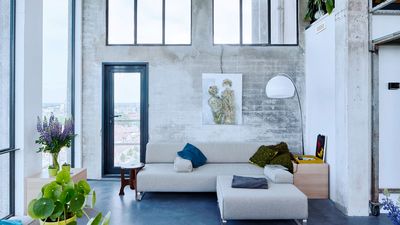
Are there certain elements from the old silo that were preserved in the new interior?
Anjo: Yes, so many, almost too many to name. The legs of the dining table were made from the funnels that used to be in this space, funnels that guided the grain. And the bench outside on the roof terrace used to be a tackle chain.
José: There’s a framed document on the wall, listing all the different types of grain this silo used to store. Just yesterday, one of our neighbors gave me these jars filled with those grains, such a nice gesture.
What do you like the most about living in an old silo?
Anjo: There’s a lot of privacy, despite the large windows. You never feel like someone is watching you, even though I’m sure people do look up sometimes. We have a peregrine falcon nest on the roof, so sometimes we notice bird watchers looking up with their binoculars to check if the falcon is home. He’s not here right now, so I have to disappoint people.
José: You notice the weather a lot more clearly from up here. All those different types of clouds and weather systems, it starts to fascinate you. Sometimes you see weather phenomena that disappears after just a few seconds, that’s quite something to witness.
It’s funny how living in such a modern, industrial building has brought you closer to nature in that sense.
Anjo: You really experience the seasons from inside this house, because there’s so many windows. You notice immediately when the leaves are falling, or when everything turns green.
José: We’ll be sitting somewhere, and someone will see something outside the window in the distance, and you get distracted and walk over to take a look. It’s a very dynamic place to live.









